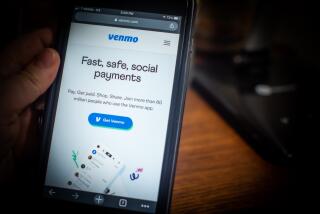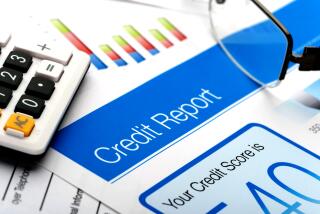Person-to-Person Payments Still Better in Person
- Share via
So, I owed my brother some money, and I thought it might be hip to e-mail him the dough with one of those new online person-to-person payment sites, which would zap money from my bank account to his.
My brother, it turned out, didn’t appreciate this experiment with the “new economy.” He complained about having to take time out of his day to figure out how to retrieve his cash. He fretted over providing personal information, such as his bank account number, to an unfamiliar Web site. Worst of all, he resented being forced to “agree to their terms.”
At first I thought he overreacted and just lacked tech-coolness. But after testing several of these payment sites myself, I share his frustration.
Online person-to-person payments is a novel concept, but so far no one has mastered the right blend of speed, simplicity and affordability to make it much of a threat to the old-fashioned method of just reaching in your pocket for cash or writing a check. Most of these sites take your money quickly and easily. Getting it out again can be tricky.
Nevertheless, the business is booming. New sites are being launched regularly, some backed by well-known technology investors and giant banks. PayPal, one of the nation’s largest, has signed up nearly 3 million users.
Much of the growth is being fueled by online auctions and e-commerce. The sites may be great for shopping on EBay, but for repaying a friend who picked up the lunch tab or sending little Genevieve that birthday cash, online payment sites still have bumps to be worked out.
They all basically do the same thing. The sites deduct money from a sender’s checking account or credit card and then e-mail a notice to the recipient. The recipient links to the provider’s Web site, registers and then directs the money into their own bank account or credit card.
Advantages?
Most of the sites are free. There’s no need to search for an envelope or postage stamp to mail a check. Because money is being transferred electronically, it can be faster (though that’s not always the case).
It’s also a sneaky way to get a no-fee cash advance on your credit card (by sending money from your credit card to your own checking account) or racking up extra airline miles or other rewards on your credit card. But both credit card issuers and online payment services frown on such practices and may terminate your account if you get caught.
There are hassles and disadvantages too. Many services require that users set up special “accounts” at their Web sites and then pre-fund them with money debited from a credit card or checking account. That way, the Web site can earn interest on your inactive money until you send it out or until the recipient claims it.
Privacy is another worry. Many users will object to some sites’ request for their Social Security numbers, credit card numbers, phone numbers or driver’s license numbers. And because of a growing fraud problem on online-payments sites, many are asking for additional personal data in order to verify users’ identity.
Meanwhile, privacy protections vary. A few sites will share personal information about you and your finances with marketers, advertisers or other third parties.
Lastly, some sites are much more complicated than they need to be, particularly for those who are not tech-savvy.
Here’s a roundup of seven online-payment sites, ranked from best to worst.
PayPlace.com
In a field of lackluster players, PayPlace was the best all around. Signing up was simple. Customer service was attentive; I got an e-mail response to a question in under half an hour. Best of all, recipients will find it easy to navigate their way through the sign-up procedure and access their money.
It’s also the best site for sending money from one individual’s credit card to another’s. For many users, this card-to-card transfer will be the fastest and least-invasive way to move money. PayPlace also accepts all three major credit cards. But be aware, some major credit card issuers will not accept deposits from these sites, which means recipients might have to try a couple of different cards before finding one that will accept the money.
There are a couple of drawbacks. You must pre-fund a PayPlace account, which adds an unnecessary step, and you can’t pre-fund an account by electronically withdrawing money from your checking account. (Though you can get around that by using a debit card with a Visa or MasterCard logo.)
Also, the company may share personal information about users in order to “determine the response to our advertising on other sites.” I don’t know exactly what that means, but it doesn’t sound good.
EMoneyMail.com
If it weren’t for the $1 fee, Bank One’s EMoneyMail would likely be my top choice. But it’s hard to justify that kind of charge when most other sites are free. It just shows how much banks love those pesky fees.
Another drawback is that EMoneyMail only accepts Visa, so if you have a MasterCard or American Express, you’re out of luck.
But for ease and simplicity, EMoneyMail is the hands-down winner. Registering is a breeze and far less invasive than other sites. No address or phone number. And there’s no need to pre-fund an account and let Bank One earn interest on your unused balances.
Problems with fraud, however, are causing the bank to retool the site. It recently lowered the maximum transaction limit from $500 a day to $300. And the bank may start to request more personal information to verify a user’s identity.
Achex.com
The biggest drawback here is the lack of credit cards. The only option is sending cash to and from a checking account. As a result, signing up takes longer and requires more personal information, including checking account number, “router” numbers (part of that mysterious long string of numbers on your checks) and, most annoyingly, Social Security numbers. So your friend will have to fork over his or her SSN just to get the cash. That’s likely to be a big turnoff, particularly to someone who has no plans to use the service again.
Privacy protection is so-so. In some cases, Achex might share personally identifiable information about you with merchants.
Like EMoneyMail, there’s no need to pre-fund an account, and unlike most other sites, money is not debited from the sender’s account until the recipient requests it.
PayPal.com
For some reason, PayPal seems determined to get your bank account number. The sign-up process is simple, but unless you link your PayPal account to a traditional checking account, transactions are limited to $500. Not $500 a day, like other sites. A lifetime total of $500. After that, you can’t use the service anymore unless you give them your bank account number, which many users are loath to do.
So for those preferring credit cards, PayPal is not the best option. You can use a Visa or MasterCard to pre-fund your PayPal account, but recipients can not use credit cards to accept payments. They must have money electronically transferred to their checking account or request a paper check, which can take up to two weeks.
For recipients and new users, PayPal can be confusing. They don’t exactly go out of their way to show new users how to move money from a PayPal account to the recipient’s own bank account. This is unfortunate because many recipients are likely to be first-time users.
MoneyZap.com
Consumers worried about protecting their privacy will want to steer clear of MoneyZap, a new service offered by Western Union. The company collects personal information about customers (and former customers), including details about their financial status and transactions. Then MoneyZap shares the data with marketing firms, retailers, credit card issuers, brokerages, catalog companies and others. The disclosure policy is spelled out on its Web site and users have an opportunity during registration to opt out of some of the information sharing. But even if you opt out, MoneyZap will still share your personal information with Western Union, its parent First Data Corp. and other affiliated companies.
Even scarier, hackers recently stole credit card information about Western Union customers because employees left the Web site unprotected during a maintenance procedure.
Another concern is price. Currently, the fee is waived, but the company says it will start charging about $2 per transaction next year. Ouch.
PayMe.com
With backing from stock trader ETrade Group and tech incubator Idealab, you’d expect more from PayMe.com. Besides being dull graphically, the sign-up procedure was tedious and invasive, requiring a work phone number, home phone number, Social Security number, birth date and driver’s license number. Come on, guys. I’m not applying for a mortgage. Why not ask for my tax returns too?
The privacy policy seems solid, but it can take as long as nine days for money to be transferred to the recipient, longer than most of the rest.
Plus, when I tried to send money, I was unable to activate an account and received various red-lettered explanations before being dumped off the system. First it rejected my credit card, saying my issuer does not accept electronic deposits. (The same card worked fine at other sites.) I tried another credit card but was told that number was invalid. Wrong. That card worked fine at other sites too.
After reentering the card number four times, I e-mailed a plea for help. Two hours later, I got a response--suggesting I call an 800-number. Next!
Ecount.com
Talk about over-complicating something. Don’t waste your time here. Ecount takes your money and doesn’t let go. It’s fairly easy to put money into Ecount (though there are some problems and delays in the registration process). But pity the recipient.
Ecount no longer allows recipients to transfer money directly to their credit card. So now, recipients have three equally unattractive options: 1. Use Ecount funds to shop online at a participating merchant. 2. Pay for an Ecount credit card for $4.95 and have the balance transferred to the card. 3. Request a paper check.
They even make paper checks complicated. Before you can request a check, you must wait for Ecount to mail a verification code to your home address. Then you enter the code on the Web site to confirm your mailing address. Then they mail you a paper check--and have the nerve to charge the recipient $1 for the service. The company says it hopes to soon permit recipients to transfer money to their checking accounts. Until then, skip Ecount and just mail your friend a check yourself.
To read past E-Review columns, go to https://www.latimes.com/ereview.
More to Read
Inside the business of entertainment
The Wide Shot brings you news, analysis and insights on everything from streaming wars to production — and what it all means for the future.
You may occasionally receive promotional content from the Los Angeles Times.










